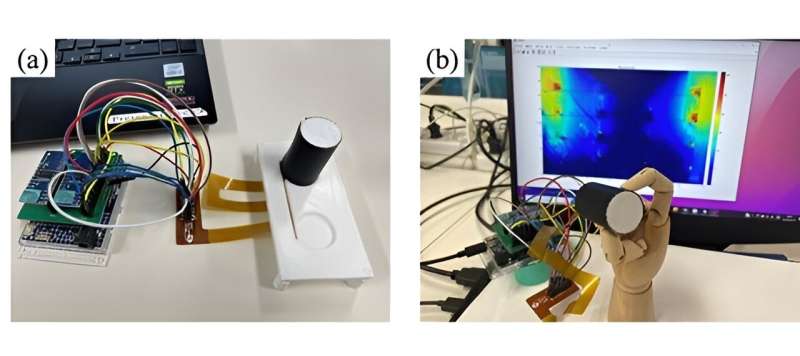This article has been reviewed according to Science X's editorial process and policies. Editors have highlighted the following attributes while ensuring the content's credibility:
fact-checked
peer-reviewed publication
trusted source
proofread
EIT-based tactile sensor provides new approach to fine motor skills assessment

Fine motor skills play a crucial role in human cognition, influencing everything from daily activities to the development of advanced tool-based civilizations. Yet, quantifying and evaluating these skills objectively has been a challenge.
Conventional techniques like video coding, although efficient, are time-intensive and susceptible to coder bias. Additionally, existing technologies like marker less motion capture or hand-attached devices have limitations, especially when assessing infants' finger movements.
Addressing these challenges, a study led by Professor Hiroki Sato from Shibaura Institute of Technology, in collaboration with Mr. Ryunosuke Asahi also from Shibaura Institute of Technology and Dr. Shunsuke Yoshimoto from the University of Tokyo, now affiliated with Osaka University, has emerged. This research introduces a novel method for objective evaluation of fine finger movements.
This study, published in IEEE Access, presents a cutting-edge system utilizing a flexible tactile sensor based on electrical impedance tomography (EIT).
Prof. Sato explains, "We have extended Dr. Yoshimoto's previously developed flexible tactile sensor based on electrical impedance tomography (EIT). This extension has resulted in the creation of a novel system for objective evaluation of fine finger movements. This system offers significant advantages in terms of flexibility, shape versatility, and sensitivity compared to conventional methods."
Their device, comprising four layers including a flexible tactile sensor based on electrical impedance tomography (EIT) has a cylindrical shape akin to the FDT pegboard (Functional Dexterity Test). This setup enables precise measurement of pinching motions.
Using a flexible printed circuit board with 16 electrodes and conductive materials, the sensor captured voltage data from different finger movements. The data was processed using MATLAB to reconstruct images and classify pinching motions. In experiments involving 12 participants, this system achieved high classification accuracies, with reconstructed images and measured voltage vectors.
The research fills a critical gap in current evaluation techniques by introducing a system capable of accurately classifying various pinching motions. Detailing their methodology and results, Prof. Sato notes, "In this study, 12 adult participants performed six types of pinching motions characterized by the number of fingers and their direction. The voltage vector and reconstructed images were used to classify the six types of pinching motions.
"Our results showed classification accuracies of 79.1% and 91.4% for the use of reconstructed images and measured voltage vectors, respectively."
This breakthrough has profound implications for both research and practical applications. Notably, it can pave the way for educational toys designed to enhance fine finger movements, thus helping in cognitive development. Moreover, automated analysis of hand movements can address the manpower shortage in medical research and contribute to the realization of online medical care.
Prof. Sato and his team envision even broader applications for their system in the future. "In the future, we plan to apply the tomographic tactile sensor to objects of various shapes to confirm its feasibility for a wide range of people, particularly infants," he further adds.
The development of this novel system marks a significant advancement in the objective evaluation of fine finger movements. With its potential to be applied to various fields, from developmental assessments to medical research, this technology promises a brighter future where the intricacies of human motor skills are better understood and utilized for the benefit of society.
More information: Ryunosuke Asahi et al, Development of Pinching Motion Classification Method Using EIT-Based Tactile Sensor, IEEE Access (2024). DOI: 10.1109/ACCESS.2024.3395271




















